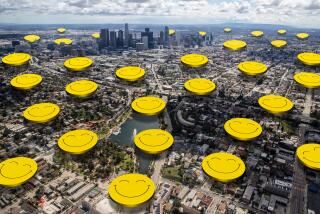Temples to Mark Birth of Buddha
A visitor immediately notices the fragrance of incense when entering the Higashi Honganji Buddhist Temple in Little Tokyo. The sweet odor, say Buddhists, is similar to the goodwill a selfless individual diffuses on humanity.
Incense is also burned by Buddhists in remembrance of the deceased.
And much incense will be burned Sunday during special ceremonies as Southland Buddhists meet at their temples to celebrate Buddha’s birthday.
Los Angeles County is home to between 20 and 30 Buddhist temples and thousands of adherents. Many of the temples offer tours, which can be arranged by calling in advance.
At Higashi Honganji, for example, the baby Buddha’s image will be placed in a flower-festooned altar, and visitors will be invited to ladle sweet wine over it. Legends say that when the Buddha was born, sweet rain fell and flowers bloomed.
The Buddha’s image at the Higashi Temple is housed in a gilded altar, attended by black lacquered artifacts and golden candle holders adorned with real and mythical animals.
Each symbolizes a Buddhist virtue. An incense burner topped by a lion represents wisdom, said Bishop Gyoko Saito.
“The elephant represents compassion. Dragons signify freedom, since they can fly, swim and run. Many Buddhist temples in Japan have dragons painted on the ceilings,” he said.
Four chains of gold in leaf and fan motifs strung from the ceiling are representations of jewels, the bishop said. These material objects are used to complement the Buddha image.
Buddhism was originated in India 2,500 years ago by its founder, Siddhartha Gautama, the crown prince of a small country now known as Nepal.
At 29, he left his kingdom, deeply troubled after witnessing poverty, illness and death among his people. Thus began the prince’s search for life’s meaning.
After six years of wandering and meditating, he attained enlightenment and took the name Buddha, which means Enlightened One. Gautama traveled through India, preaching until his death at 80.
Buddhism spread to China and Tibet 2,000 years ago. In the 7th Century, Buddhism entered Korea and Japan, said Saito. In each country, Buddhism changed subtly.
“In Sri Lanka, Thailand and Burma, monks followed the original form for 2,500 years,” said Saito. “They stay in the temple, studying and teaching. There, monks live an austere life, eating simply and not marrying. Their only possession is a bowl, which they use when going out to the community to beg for food.”
Buddhism changed in China, which already had its own religions--Taoism and Confucianism. And when Buddhism reached Japan, it changed again.
“The Japanese had a fondness for aesthetics, and Buddhism affected the arts,” he said.
Buddhism established a foothold in California in 1899 with Japanese immigrants who arrived in San Francisco. Although there are about 56 Buddhist sects, each with its own philosophy, basic to Buddhism are the Four Noble Truths and the Eightfold Path.
In 1904, the first Higashi Honganji Temple was founded in Los Angeles. Hon means “original,” gan means “bow,” and ji means “temple.” The current temple on 3rd Street was built 14 years ago.
A teacher of Saito said that attaining the original mind is one’s goal as a Buddhist.
“People are born with the purest of desires, but in the process of growing, they lose it. Pure desire is the essence of life,” he said.
The pure religious mind is characterized by oneness with living beings. He illustrated with a story:
“A friend of mine visited his son, daughter-in-law and grandson. The family also had two dogs.
“During the visit, the 2-year-old wandered off. They searched the neighborhood but couldn’t find him.
“By pure accident, my friend passed by the doghouse and noticed one of the dogs sitting awkwardly in the entrance. On closer inspection, he found his grandson sleeping in the doghouse.
“My friend told me, ‘My grandson has the purest religious mind. He doesn’t separate his life from his pets.’ ”
In Los Angeles County, Buddhist temples include:
* Bool Kook Temple, 1411 W. Olympic Blvd.; (213) 380-0108.
* Burma Buddhist Monastery, 115 S. Commonwealth Ave.; (213) 382-9477.
* Cimarron Zen Center of Rinzai-Ji, 2505 Cimarron St.; (213) 732-2263.
* Dharma Realm Buddhist Assn., 1728 W. 6th St.; (213) 483-7497.
* Federation of Young Korean Buddhists of Southern California, 4023 Ingraham St.; (213) 383-7552.
* Higashi Honganji Buddhist Temple, 505 E. 3rd St.; (213) 626-4200.
* Jodo Shu Temple, 2003 W. Jefferson Blvd.; (213) 732-9273.
* Korean Buddhist Kwam Um Sa Temple, 4265 W. 3rd St.; (213) 380-3302.
* Koyasan Buddhist Temple, 342 E. 1st St.; (213) 624-1267.
* Nishi Hongwanji Buddhist Temple, 815 E. 1st St.; (213) 680-9130.
* Pho Da Son Quan A Po Tat Tu, Inc. 1349 N. Broadway; (213) 224-8626.
* Southern California Chinese Buddhist Temple, 1315 W. Sunset Blvd.; (213) 250-5262.
* Tahl Mah Sah Buddhist Monastery and Temple of America, Inc., 3505 W. Olympic Blvd.; (213) 735-1911.
* Vietnamese Buddhist Temple, 863 S. Berendo St.; (213) 384-9638.
* Won Buddhism of America, 1717 S. Hoover St.; (213) 747-7123.
* World Buddhism Assn. of America, 122 Ord St.; (213) 621-2466.
* Zen Center of Los Angeles, 923 S. Normandie Ave.; (213) 387-2351.
* Zenshuji Soto Mission, 123 S. Hewitt St.; (213) 624-8658.
* Buddha’s birthday celebration at Southland Buddhist temples. For more information or to arrange tours, check listing of local temples. For general information on Buddhist activities, call the Japanese American Cultural and Community Center, 244 S. San Pedro St., Los Angeles; (213) 628-2725.
More to Read
Sign up for The Wild
We’ll help you find the best places to hike, bike and run, as well as the perfect silent spots for meditation and yoga.
You may occasionally receive promotional content from the Los Angeles Times.






